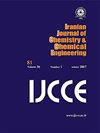Investigation of Thermal Decomposition Kinetics of Some RDX Based Material
IF 1
4区 工程技术
Q4 CHEMISTRY, MULTIDISCIPLINARY
Iranian Journal of Chemistry & Chemical Engineering-international English Edition
Pub Date : 2021-09-28
DOI:10.30492/IJCCE.2021.118941.3887
引用次数: 0
Abstract
The aim of the current study is to compare thermal decomposition kinetics of three 1, 3, 5-trinitro-1, 3, 5-triazinane (RDX) based explosives, containing A4, H6, and PBXW-108 using TGA/DSC experimental techniques and analytical methods. The experimental part of the study performed non-isothermally at 1, 2, 5, 10, 15, and 20 °C min-1 heating rates. A complementary approach which is a combination of model free isoconversional methods and model fitting methods was carried out to achieve more accurate results for the kinetic parameters. Moreover, Arrhenius parameters were determined by non-isoconversional Kissinger’s method. The values of the self-accelerating decomposition temperature (TSADT)and the critical ignition temperature (Tb) were also calculated. The results indicated that PBXW-108, a plastic bonded explosive, in comparison to H6 and A4 has the highest pre-exponential factor and activation energy of decomposition. Moreover, TSADT and Tb of PBXW-108 are higher than those of A4 and H6. Therefore, PBXW-108 can be introduced as a safer alternative to traditional A4 and H6 explosives. According to the obtained results, the contracting area model (R2) is the best choice for describing both PBXW-108 and H6 decompositions, while the F1/3 model is the suitable one for A4.某些RDX基材料的热分解动力学研究
本研究的目的是利用TGA/DSC实验技术和分析方法比较含有A4、H6和PBXW-108的三种1,3,5 -三硝基1,3,5 -三嗪烷(RDX)炸药的热分解动力学。本研究的实验部分在1、2、5、10、15和20℃min-1加热速率下进行非等温加热。采用无模型等转换方法和模型拟合方法相结合的互补方法,可获得更精确的动力学参数。此外,阿伦尼乌斯参数采用非等转换基辛格方法确定。计算了自加速分解温度(TSADT)和临界点火温度(Tb)。结果表明,与H6和A4相比,PBXW-108塑性粘结炸药的指前因子和分解活化能最高。PBXW-108的TSADT和Tb均高于A4和H6。因此,可以引入PBXW-108作为传统A4和H6炸药的更安全的替代品。结果表明,对于PBXW-108和H6的分解,收缩面积模型(R2)是最合适的描述,而对于A4的分解,收缩面积模型(F1/3)是最合适的描述。
本文章由计算机程序翻译,如有差异,请以英文原文为准。
求助全文
约1分钟内获得全文
求助全文
来源期刊

Iranian Journal of Chemistry & Chemical Engineering-international English Edition
CHEMISTRY, MULTIDISCIPLINARY-ENGINEERING, CHEMICAL
CiteScore
2.80
自引率
22.20%
发文量
0
审稿时长
6-12 weeks
期刊介绍:
The aim of the Iranian Journal of Chemistry and Chemical Engineering is to foster the growth of educational, scientific and Industrial Research activities among chemists and chemical engineers and to provide a medium for mutual communication and relations between Iranian academia and the industry on the one hand, and the world the scientific community on the other.
 求助内容:
求助内容: 应助结果提醒方式:
应助结果提醒方式:


